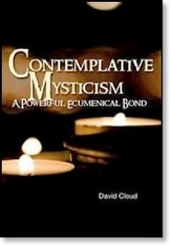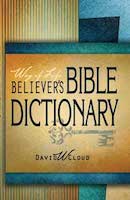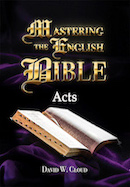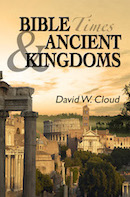866-295-4143, fbns@wayoflife.org

Pierre Teilhard de Chardin (1881-1955) was a French philosopher and Jesuit priest who taught New Age mystical doctrine. De Chardin was not his last name but was a French aristocratic title.
His mother was fervently devoted to the Catholic “saints and mystics,” and he inherited this passion. He became a great devotee of the Catholic Mary:
“At home, his mother had nurtured Pierre’s love of ‘the little Jesus’ and encouraged his devotion to both the infant Christ and his mother Mary. ... he made an act of personal consecration to the Blessed Virgin on the Feast of the Immaculate Conception. Devotion to Our Lady became deeply rooted in his heart, and, in 1895, he joined the Sodality of the Immaculate Conception. Throughout his life Mary was to hold a special place in his meditations and retreats, and he always remained faithful to the recitation of the rosary” (Ursula King, Spirit of Fire: The Life and Vision of Teilhard de Chardin, pp. 2, 4, 11).
This is idolatry, and it is no surprise that he was drawn through the contemplative devotion to Catholic idols to a devotion to the panentheistic “heart of matter.” The same deceiving spirits are behind the worship of Mary and the worship of nature. He later wrote, “The truth is that even at the peak of my spiritual trajectory I was never to feel at home unless immersed in an Ocean of Matter” (Teilhard, The Heart of Matter).
“His inner attraction to the great forces of nature, so deeply rooted in earlier childhood experiences, became so immensely strong that it awakened in him a vibrant cosmic consciousness--an experience of such intensity that he felt divine vibrations running through all things. ... when surrendering himself ‘to the embrace of the visible and tangible universe,’ he learned to feel the hand of God. And when he saw, ‘as though in ecstasy, that through all of nature I was immersed in God.’ He now became fully aware of a deeply pantheistic and mystical inclination in him. This vibrant sense of a strong nature mysticism was to remain with him all his life” (Ursula King, Spirit of Fire, pp. 19, 20).
He even wrote a Hymn to Matter:
“Blessed be you, harsh matter, barren soil, stubborn rock ... Blessed be you, perilous matter, violent sea, untameable passion. ... I bless you, matter, and you I acclaim ... as you reveal yourself to me today, in your totality and true nature.”
He expressed his pantheistic view as follows:
“There is a communion with God, and a communion with earth, and a communion with God through earth” (Teilhard, Cosmic Life, 1916).
Teilhard was trained by the Jesuits from age 11 and ordained to the priesthood in 1911.
He is referred to in a positive manner by many within the contemplative movement. In the introduction to his edition of The Cloud of Unknowing, William Johnston refers to “the dynamic approach of Teilhard de Chardin,” calling it “biblical.” Richard Foster includes a chapter by Teilhard in his book Spiritual Disciplines. Larry Crabb recommends Teilhard’s book The Divine Milieu. Brennan Manning quotes sympathetically from Teilhard. John Michael Talbot says, “Teilhard de Chardin broke yet new ground with his Cosmic Christ, and a revolutionary marriage between science and mysticism” (Come to the Quiet, p. 95). John Yungblut combined Christian contemplation with Jungian psychology and Teilhard’s doctrine of the evolution of the universe. Bret McCracken, in Hipster Christianity, says cool emerging Christians identify with Teilhard (p. 98).
Teilhard’s (pronounced tay-yar) major writings include The Phenomenon of Man (1955), The Divine Milieu (1957), The Future of Man (1959), Human Energy (1962), The Activation of Energy (1963), Hymn of the Universe (1964), and Christianity and Evolution (1969).
Teilhard was “a leading proponent of orthogenesis, the idea that evolution occurs in a directional, goal driven way” (“Pierre Teilhard de Chardin,” Wikipedia). He called it “sacred evolution.” He didn’t believe in blind naturalistic evolution as per Darwin or Huxley, but in evolution as the tool used by “God” to create and perfect the universe. He described “sacred evolution” as follows:
“In very truth, it is God, and God alone whose Spirit stirs up the whole mass of the universe in ferment. ... The fact is that creation has never stopped. The creative act is one huge continual gesture, drawn out over the totality of time. It is still going on” (The Mystical Milieu, 1917).
This is a blatant denial of the Bible’s teaching that God made the heaven and earth in six “evening and morning” days and that He rested from creation on the seventh day.
Teilhard’s views on evolution were influenced through studies at the Museum of National History in Paris and by evolutionists Henri Bergson and Theodosius Dobzhansky. The New York Times for March 19, 1937, described Teilhard as “the Jesuit who held that man descended from monkeys.” Teilhard carried out research into man’s evolution, making extended paleontological* explorations in China and elsewhere. He was one of discoverers of the Peking Man in China and helped excavate the gravel pit in England where the Piltdown Man was discovered, both supposed “missing links” between man and apes. The Piltdown Man was exposed in 1953 as a deliberate forgery consisting of the lower jawbone of an orangutan combined with the skull of a man. Teilhard’s role in the hoax is unknown. (* Paleontology is the study of prehistoric life forms through the examination of fossils.)
One of Teilhard’s scientific colleagues was Julian Huxley, who helped promote Teilhard’s writings and penned the foreword to the 1959 edition of The Phenomenon of Man. Julian was the grandson of the infamous Thomas Huxley (1825-1893), the friend of Charles Darwin who turned Darwinian evolution into a campaign against God. Julian was a brash evolutionist in his own right. He developed the “modern synthesis,” the unified form of evolution that is accepted by the great majority of biologists and that basically declares evolution by natural selection a fact rather than a theory, claiming that is consistent with all modern “scientific” findings in every field of biology. Julian was an atheistic humanist, the first director of UNESCO, a founding member of the World Wildlife Fund, and a proponent of human population control. Julian’s brother, Aldous, was a Hindu mystic who claimed to have found enlightenment through drugs.
Teilhard taught that God is the consciousness of the universe, that everything is one, and that everything is evolving in greater and greater enlightenment toward an ultimate point of perfection. He called this perfection CHRIST, THE SPIRIT OF THE EARTH, and THE OMEGA POINT. Teilhard spoke much of Christ, but his Christ was not the Christ of the Bible.
New Ager Brian Swimme, a Teilhard disciple, says:
“You could summarize his thought simplistically and say that the universe begins with matter, develops into life, develops into thought, develops into God. That’s his whole vision, right there. Now clearly, this God that develops--it’s not as if God is developed out of matter. God is present from the very beginning, but in an implicit form, and the universe is accomplishing this great work of making divinity explicit” (Susan Bridle, “The Divinization of the Cosmos: An Interview with Brian Swimme on Pierre Teilhard de Chardin,” http://www.wie.org/j19/teilhard.asp?page=2).
Teilhard wrote:
“All around us, to right and left, in front and behind, above and below, we have only to go a little beyond the frontier of sensible appearances in order to see the divine welling up and showing through. But it is not only close to us, in front of us, that the divine presence has revealed itself. It has sprung up universally, and we find ourselves so surrounded and transfixed by it, that there is no room left to fall down and adore it, even within ourselves. By means of all created things, without exception, the divine assails us, penetrates us and moulds us. We imagined it as distant and inaccessible, whereas in fact we live steeped in its burning layers” (The Divine Milieu).
This is not the transcendent Creator God of the Bible, but the monistic God of Hinduism. Teilhard described himself as a pantheist.
“What I am proposing to do is to narrow that gap between pantheism and Christianity by bringing out what one might call the Christian soul of Pantheism of the pantheist aspect of Christianity” (Christianity and Evolution, p. 56).
“Now I realize that on the model of the incarnate God whom Christianity reveals to me, I can be saved only by becoming one with the universe. Thereby, too, my deepest pantheist’ aspirations are satisfied” (Christianity and Evolution, p. 128).
To Teilhard, all men’s souls constitute the “soul of the world” which is evolving toward the “ultimate convergence in perfection on Omega and the Christ” (Anne Bancroft, Twentieth-Century Mystics, p. 55). Thus, man is part of the divine and will eventually merge with it. He called his theory of evolution the Law of Complexity, claiming that the Omega Point is drawing the universe to itself so that it is being guided toward ever higher states of consciousness. He described the Omega Point as a divine personal intellectual being that is outside of the framework of evolution and that is guiding the evolution.
Teilhard denied every major doctrine of the Bible. He denied the transcendent holy creator God, Satan, the fall of man, the unique divinity of Jesus, the substitutionary atonement, the bodily resurrection, and salvation through personal faith in Jesus Christ.
Of Adam he wrote:
“There is a two-fold and serious difficulty in retaining the former representation of original sin. It may be expressed as follows: ‘The more we bring the past to life again by means of science, the less we can accommodate either Adam or the earthly paradise” (“Note on Some Possible Historical Representations of Original Sin,” 1922).
Teilhard taught that evolution has progressed in three stages, the geosphere, the biosphere, and the noosphere. The geosphere (inanimate matter) was formed first, followed by the biosphere (biological life). The NOOSPHERE is the “sphere of human thought” or “collective consciousness” that is now supposedly evolving toward perfection. “It is like a thinking envelope of the earth of which all humans are part. All contribute to it through their thinking, feeling, connecting, and interacting with each other, and above all, through their powers of love” (King, Spirit of Fire, p. 88). Modern technological achievements such as the Internet are seen by many as a fulfillment of this evolutionary leap. Teilhard called the early computers at Berkeley and Harvard “the last word in systematization after the last word in energy” (King, p. 214). “According to Tom Wolfe’s 2000 book Hooking Up, the teachings of Teilhard de Chardin influenced many of the engineers that were the creators of Silicon Valley in California” (“Pierre Teilhard,” Wikipedia). Lyndon LaRouche, who ran for the U.S. presidency, based his political theories on the importance of the noosphere in human development.
In The Phenomenon of Man (1968) Teilhard claimed that mankind is on the verge of an evolutionary leap in consciousness similar to that allegedly achieved when man emerged from the animal kingdom.
“All around us, tangibly and materially, the thinking envelope of the Earth--the Noosphere--is multiplying its internal fibers and tightening its network; and simultaneously its internal temperature is rising, and with this its psychic potential” (Teilhard, The Planetization of Mankind).
He “believed the new consciousness would be similar to mystical enlightenment in that it was likely to have collective and cosmic elements which would have the effect of drawing individuals closer to God” (The Aquarian Guide to the New Age). New Agers such as Barbara Hubbard have latched onto this doctrine as foundational to their agenda.
He believed that “a new mysticism is developing where religion and science can animate and mutually transform each other” (King, Spirit of Fire, p. 176). This is exactly what is happening through the “intelligent design” movement. Many scientists are acknowledging that naturalistic principles alone cannot explain life, but they also continue to reject the Almighty Creator God of Scripture. In His place, they postulate some sort of New Age higher power. For example, Francis Collins, director of the Human Genome Project, says:
“I’m a scientist that believes the tools of science are the way to understand the natural world and one needs to be rigorous about that. But I’m also a believer in a personal God. I find the scientific worldview and the spiritual worldview to be entirely complementary. And I find it quite wonderful to be able to have both of those worldviews existing in my life in a given day, because each illuminates the other” (video presentation at the American Museum of Natural History’s Spitzer Hall of Human Origins).
This might sound respectful toward “religion,” but in fact it is a bold repudiation of the Bible, because the Bible refuses to speak only about “religious things.” The Bible begins with a plain account of how the universe was made, so it refuses to leave such things to “science.” And if the Bible is wrong about the material universe there is no reason to believe it is right about anything else and no reason to “respect” its teachings on any other subject.
(See “Darwinian Gods,” a chapter in the book Seeing the Non-existent: Evolution’s Myths and Hoaxes, available from Way of Life Literature.)
Teilhard said:
“The outcome of the world, the gates of the future, the entry into the super-human--these are not thrown open to a few of the privileged nor to one chosen people to the exclusion of all others. They will open only to an advance of all together, in a direction in which all together can join and find completion in a spiritual renovation of the earth” (The Phenomenon of Man, p. 245).
This is the New Age theme that the world must reach its new level of evolutionary transformation as a whole and that those who resist are enemies of world peace and blessing. It calls to mind the New Age techniques of building community through dialogue and religious tolerance.
Teilhard was a mystic and described his practice of meditation as “going down into my innermost self, to the deep abyss” (The Divine Milieu, p. 76). He said: “At each step of the descent a new person was disclosed within me of whose name I was no longer sure, and who no longer obeyed me.” At the end of the journey he found “a bottomless abyss at my feet.”
This is a loud warning to those who have ears to hear. Though the mystic believes that he is touching light and truth through contemplative practices, in reality he is fellowshipping with darkness and devils. Who were these “persons” who were distinct from Teilhard himself and who did not obey him? From a biblical perspective, we would have to conclude that the man was communicating with demons.
Teilhard said he was led along by a spirit all his life.
“Ever since my childhood an enigmatic force had been impelling me” (Teilhard, The Heart of the Matter, 1979, p. 53).
It was this “enigmatic force” that led Teilhard to reject the Christ of the Bible.
Teilhard said that mysticism is the heart of true religion, and mysticism is a pantheistic faith in the unity of the universe.
“Without mysticism, there can be no successful religion: and there can be no well-founded mysticism apart from faith in some unification of the universe” (“The Road of the West: To a New Mysticism,” cited from Ursala King, Spirit of Fire, p. 141).
He believed this new mysticism would create a new religion:
“One might say that a hitherto unknown form of religion--one that no one could as yet have imagined or described, for a lack of a universe large enough and organic enough to contain it--is burgeoning in the heart of modern man, from a seed sown by the idea of evolution. ... Far from being shaken in my faith by such a revolution, it is with irrepressible hope that I welcome the inevitable rise of this new mysticism and anticipate its equally inevitable triumph” (“The Stuff of the Universe”).
It is not surprising that Teilhard was drawn toward Hinduism. In questions of comparative mysticism he “always gave most attention to Indian monism and Vedanta” (King, p. 188).
In 1947 he published “The Spiritual Contribution of the Far East” in which he envisioned a “confluence of East and West.” He promoted the World Congress of Faiths and its syncretistic approach to religion as the path toward world peace and prosperity. He saw this movement as “indispensable for the future evolution of humankind” (King, pp. 189, 190).
We can see that Teilhard was led down the same path by the same spirits as Thomas Merton.
Teilhard was appreciative of the writings of Carl Jung, “with which his own thought had something in common” (King, p. 213). This is very telling, as Jung was led along by spirit guides throughout his life. (See The New Age Tower of Babel.)
Teilhard viewed Rome as essential to human evolution. He believed that “one of the poles passes through Rome, the prime pole of ascent of what in my jargon I call ‘hominization’” (Letters from a Traveler, 1962, p. 299). This is in harmony with the Bible’s description of Rome, the city on seven mountains, the city drunken with the blood of the martyrs, as Mystery Babylon, the end-time incarnation of ancient idolatrous Babylon which will unite with the antichrist during his brief reign (Revelation 17).
Teilhard was a big supporter of the United Nations, another pillar of the New Age Tower of Babel. He wrote several papers for UNESCO. He proposed to Julian Huxley an “institute for the study of human self-evolution.” (See The New Age Tower of Babel, available from Way of Life Literature -- www.wayoflife.org.)
A few days before his death Teilhard said “If in my life I haven’t been wrong, I beg God to allow me to die on Easter Sunday,” and that is exactly when he died, on Easter, April 10, 1955 (“Pierre Teilhard de Chardin,” Cambridge Encyclopedia).
This reminds us that “signs” and “fleeces” are not sure evidence of the truth. The Bible is the sole authority for discerning whether something is right or wrong, and the Bible condemned Teilhard’s beliefs. The fulfillment of 10,000 signs cannot make right that which the Bible condemns.
It is telling that Teilhard had serious doubts about his own beliefs. He wrote:
“How, most of all, can it be that ‘when I come down from the mountain’ and in spite of the glorious vision I still retain, I find that I am so little a better man, so little at peace, so incapable of expressing in my actions, and thus adequately communicating to others, the wonderful unity that I feel encompassing me? Is there, in fact, a Universal Christ, is there a Divine Milieu? OR AM I, AFTER ALL, SIMPLY THE DUPE OF A MIRAGE IN MY OWN MIND? I OFTEN ASK MYSELF THAT QUESTION” (The Heart of the Matter, 1978, pp. 99, 100).
Teilhard’s doctrine was opposed by his Catholic superiors during his lifetime, but he was rehabilitated by Pope John XXIII, the same pope who called the Second Vatican Council that marked a significant upswing in end-time ecumenism and interfaith dialogue. Teilhard was also promoted by Pope John Paul II. In an article in l’Osservatore Romano, the Vatican newspaper, Cardinal Cassoroli stated that Teilhard was “the testimony of the coherent life of a man possessed by Christ in the depths of his soul.” Cassoroli said that Teilhard “was concerned with honoring both faith and reason, and anticipated the response to John Paul II’s appeal: ‘Be not afraid, open, open wide to Christ the doors of the immense domains of culture, civilization, and progress’” (June 10, 1981). Such a statement of approval could not have been made apart from the pope’s consent.
Teilhard’s writings have wielded a large influence within Catholicism and Protestantism alike.
Following are some other quotes from Teilhard:
“[T]he Cross still stands ... But this on one condition, and one only: that it expand itself to the dimensions of a New Age, and cease to present itself to us as primarily (or even exclusively) the sign of a victory over sin” (Christianity and Evolution, pp. 219-220).
“I believe that the Messiah whom we await, whom we all without any doubt await, is the universal Christ; that is to say, the Christ of evolution” (Christianity and Evolution, p. 95).
“The Age of Nations is past. The task before us now, if we would not perish, is to build the Earth.”
“We have reached a crossroads in human evolution where the only road which leads forward is towards a common passion. ... To continue to place our hopes in a social order achieved by external violence would simply amount to our giving up all hope of carrying the Spirit of the Earth to its limits.”
“Our duty, as men and women, is to proceed as if limits to our ability did not exist. We are collaborators in creation.”
“Love alone can unite living beings so as to complete and fulfill them ... for it alone joins them by what is deepest in themselves. All we need is to imagine our ability to love developing until it embraces the totality of men and the earth.”
“Someday, after mastering winds, waves, tides and gravity, we shall harness the energy of love; and for the second time in the history of the world, man will have discovered fire.”
“We are one, after all, you and I. Together we suffer, together exist, and forever will recreate each other.”
“You are not a human being in search of a spiritual experience. You are a spiritual being immersed in a human experience.”
“We have only to believe. And the more threatening and irreducible reality appears, the more firmly and desperately we must believe. Then, little by little, we shall see the universal horror unbend, and then smile upon us, and then take us in its more than human arms.”
“... we see not only thought as participating in evolution as an anomaly or as an epiphenomenon; but evolution as so reducible to and identifiable with a progress towards thought that the movement of our souls expresses and measures the very stages of progress of evolution itself. Man discovers that he is nothing else than evolution become conscious of itself” (The Phenomenon of Man, p. 221).
“The outcome of the world, the gates of the future, the entry into the super-human--these are not thrown open to a few of the privileged nor to one chosen people to the exclusion of all others. They will open only to an advance of all together, in a direction in which all together can join and find completion in a spiritual renovation of the earth...” (The Phenomenon of Man, p. 245).
From the book CONTEMPLATIVE MYSTICISM: A POWERFUL ECUMENICAL BOND (D.W. Cloud) ISBN 978-1-58318-113-3. Contemplative mysticism, which originated with Roman Catholic and Greek Orthodox monasticism, is permeating every branch of Christianity today, including the Southern Baptist Convention. In this book we document the fact that Catholic mysticism leads inevitably to a broadminded ecumenical philosophy and to the adoption of heresies. For many, this path has led to interfaith dialogue, Buddhism, Hinduism, universalism, pantheism, panentheism, even goddess theology. One chapter is dedicated to exposing the heresies of Richard Foster: “Evangelicalism’s Mystical Sparkplug.” We describe the major contemplative practices, such as centering prayer, visualizing prayer, Jesus Prayer, Lectio Divina, and the Labyrinth. We look at the history of Roman Catholic Monasticism, beginning with the Desert Fathers and the Church Fathers, and document the heresies associated with it, such as its sacramental gospel, rejection of the Bible as sole authority, veneration of Mary, purgatory, celibacy, asceticism, allegorical interpretation of Scripture, and moral corruption. We examine the errors of contemplative mysticism, such as downplaying the centrality of the Bible, ignoring the fact that multitudes of professing Christians are not born again, exchanging the God of the Bible for a blind idol, ignoring the Bible’s warnings against associating with heresy and paganism, and downplaying the danger of spiritual delusion. In the Biographical Catalog of Contemplative Mystics we look at the lives and beliefs of 60 of the major figures in the contemplative movement, including Benedict of Nursia, Bernard of Clairvaux, Brother Lawrence, Catherine of Genoa, Catherine of Siena, Dominic, Meister Eckhart, Francis of Assisi, Madame Guyon, Hildegard of Bingen, Ignatius of Loyola, John of the Cross, Julian of Norwich, Thomas Keating, Thomas a Kempis, Brennan Manning, Thomas Merton, Henri Nouwen, Basil Pennington, John Michael Talbot, Teresa of Avila, Teresa of Lisieux, and Dallas Willard. The book contains an extensive index.
- Receive these reports by email
- www.wayoflife.org
______________________
Sharing Policy: Much of our material is available for free, such as the hundreds of articles at the Way of Life web site. Other items we sell to help fund our expensive literature and foreign church planting ministries. Way of Life's content falls into two categories: sharable and non-sharable. Things that we encourage you to share include the audio sermons, O Timothy magazine, FBIS articles, and the free eVideos and free eBooks. You are welcome to make copies of these at your own expense and share them with friends and family. You may also post parts of reports and/or entire reports to websites, blogs, etc as long as you give proper credit (citation). A link to the original report is very much appreciated as the reports are frequently updated and/or expanded. Things we do not want copied and distributed are "Store" items like the Fundamental Baptist Digital Library, print editions of our books, electronic editions of the books that we sell, the videos that we sell, etc. The items have taken years to produce at enormous expense in time and money, and we use the income from sales to help fund the ministry. We trust that your Christian honesty will preserve the integrity of this policy. "For the scripture saith, Thou shalt not muzzle the ox that treadeth out the corn. And, The labourer is worthy of his reward" (1 Timothy 5:18). Questions? support@wayoflife.org
Goal:Distributed by Way of Life Literature Inc., the Fundamental Baptist Information Service is an e-mail posting for Bible-believing Christians. Established in 1974, Way of Life Literature is a fundamental Baptist preaching and publishing ministry based in Bethel Baptist Church, London, Ontario, of which Wilbert Unger is the founding Pastor. Brother Cloud lives in South Asia where he has been a church planting missionary since 1979. Our primary goal with the FBIS is to provide material to assist preachers in the edification and protection of the churches.
Offering: Offerings are welcome if you care to make one. If you have been helped and/or blessed by our material offerings can be mailed or made online with with Visa, Mastercard, Discover, or Paypal. For information see: www.wayoflife.org/about/makeanoffering.html.





